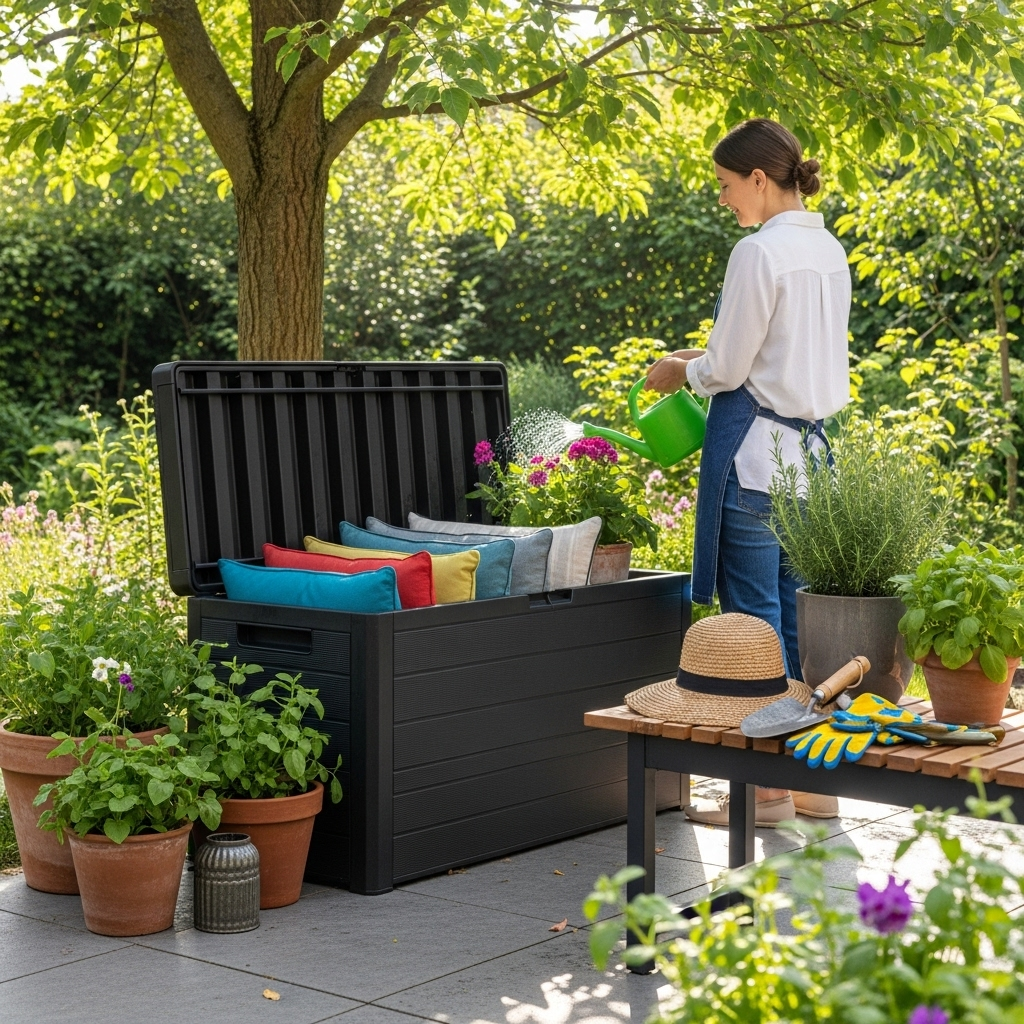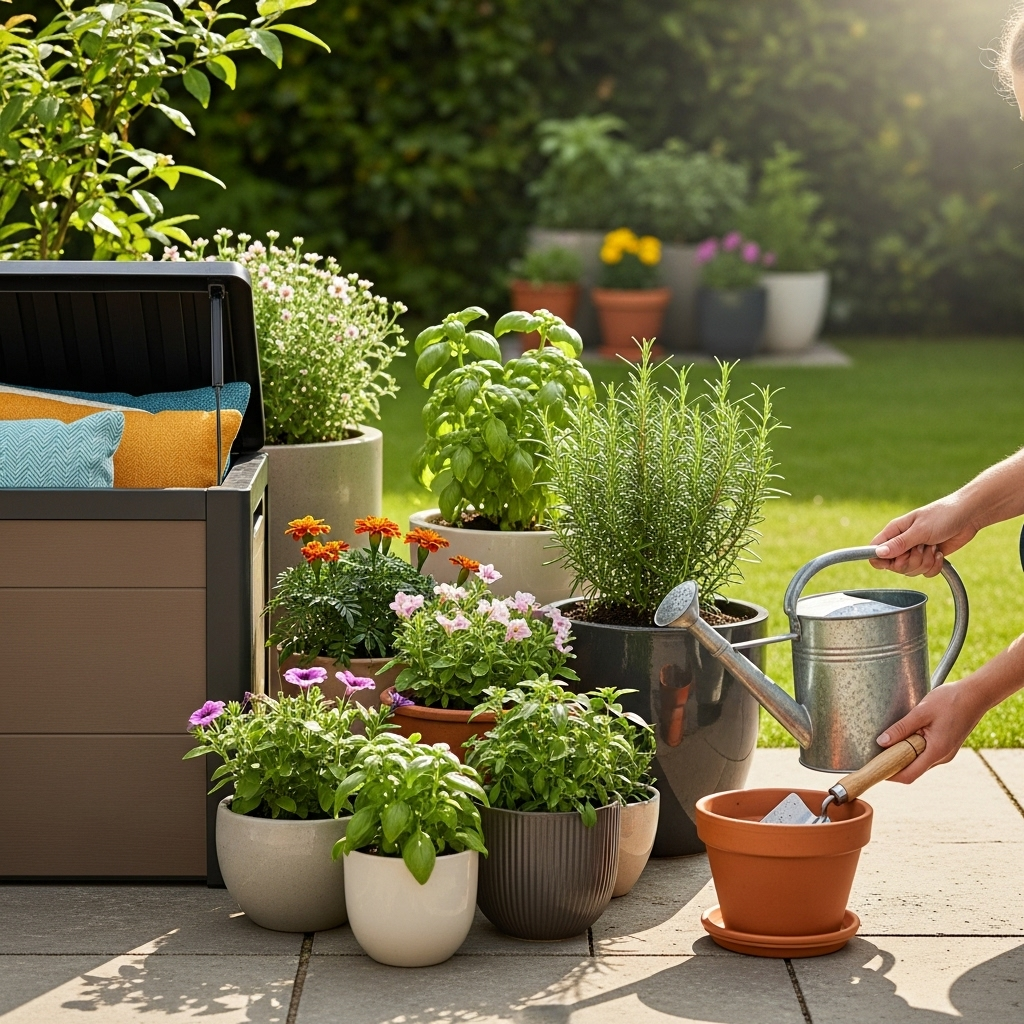A storage container for outdoor cushions keeps your patio furniture looking great and lasting longer by protecting them from weather damage and pests. This guide offers simple choices and tips to find the best, most affordable, and eco-friendly option for your needs.
Hello there, fellow garden enthusiasts! Do you love spending time in your outdoor space, but get a little frustrated when rain or sun starts to fade and damage your comfy patio cushions? It’s a common problem! Well, you’re in the right place. Finding the right storage solution can make a world of difference, turning that ‘ugh’ moment into a simple ‘aha!’ moment. We’re going to walk through everything you need to know to keep your cushions looking plush and vibrant, season after season. Let’s get those cushions cozy and protected!
Why Proper Storage for Outdoor Cushions Matters
Outdoor cushions are the unsung heroes of our patios and decks. They invite us to relax, enjoy the sunshine, and gather with friends and family. But without the right protection, these cozy companions can quickly become victims of the elements. Think of the harsh sun bleaching their colors, sudden rain showers soaking them through (leading to mildew!), and curious critters making them their new home. All of this not only shortens their lifespan but also makes them look less inviting and can even lead to costly replacements.
Investing a little time and thought into proper storage is like giving your cushions a spa day. It’s a simple step that pays off big time by preserving their beauty, comfort, and durability. You’ll save money in the long run and keep your outdoor oasis looking its best. Ready to learn how to give your cushions the protection they deserve?
The Enemies of Outdoor Cushions
- Sunlight: UV rays are powerful! They can fade vibrant colors and degrade the fabric and foam over time.
- Rain and Moisture: Even water-resistant fabrics can become saturated. Trapped moisture is a breeding ground for mold and mildew, which can be tough to remove and leave unpleasant odors.
- Dirt and Debris: Dust, pollen, leaves, and general outdoor grime can accumulate, making cushions look dingy and potentially wearing down the material.
- Pests: Insects, spiders, and even small animals might see your cushions as a cozy, sheltered place to nest. This can lead to damage and unsanitary conditions.
- Extreme Temperatures: Freezing temperatures can make some materials brittle, while intense heat can accelerate degradation.
Types of Storage Containers for Outdoor Cushions

When it comes to storing your precious outdoor cushions, you have a wonderful variety of options. Each has its own charm, price point, and functionality. Let’s explore some popular choices to help you find the perfect fit for your home and lifestyle.
1. Deck Boxes
These are perhaps the most popular and versatile storage solutions. Deck boxes are essentially large, sturdy chests designed to sit on your deck, patio, or even in your garden. They offer ample space and excellent protection.
Pros of Deck Boxes:
- Spacious: Can hold a large number of cushions, sometimes even patio furniture accessories.
- Durable: Usually made from weather-resistant materials like resin, plastic, or treated wood.
- Protective: Offer excellent defense against sun, rain, snow, and pests. Many are waterproof or highly water-resistant.
- Multi-functional: Can often double as extra seating or a small table when closed.
- Low Maintenance: Generally easy to clean and require little upkeep.
Cons of Deck Boxes:
- Size: Can be quite large and require significant space on your patio.
- Cost: Higher quality models can be an investment.
- Assembly: Some models require assembly.
- Weight: Can be heavy, especially when filled.
When choosing a deck box, look for materials like high-density polyethylene (HDPE) resin, which is known for its durability and resistance to fading. Some even have locking mechanisms for added security. You can find great resources on choosing durable outdoor furniture materials akin to those used in high-quality deck boxes at industry sites like Woodard’s blog.
2. Storage Ottomans
These are smaller, often fabric-covered or wicker-style units that can serve as footrests, extra seating, and of course, hidden storage. They are great for smaller patios or for storing fewer cushions.
Pros of Storage Ottomans:
- Compact: Smaller footprint, ideal for limited spaces.
- Lightweight: Easier to move around than deck boxes.
- Stylish: Can add a decorative touch to your outdoor seating area.
- Dual-Purpose: Serve as seating or a footrest.
Cons of Storage Ottomans:
- Limited Capacity: Cannot hold as many cushions as a deck box.
- Varying Durability: Materials can range from very durable outdoor fabrics to less weather-resistant options.
- Water Resistance: May not be fully waterproof; check product descriptions carefully.
3. Storage Benches
Similar to deck boxes but often with a more elongated, bench-like design, storage benches offer a blend of seating and storage. They are perfect for lining a walkway or placing against an outdoor wall.
Pros of Storage Benches:
- Space-Saving: Combines seating with storage in one unit.
- Aesthetic: Can complement existing outdoor furniture styles, especially wooden designs.
- Good Capacity: Typically holds more than an ottoman but less than a large deck box.
Cons of Storage Benches:
- Material: Can be made from wood (which may require more maintenance) or plastic/resin.
- Access: Sometimes lifting the seat to access cushions can be a bit cumbersome if it’s heavy.
- Weatherproofing: Ensure the compartment is well-sealed against moisture.
4. Outdoor Storage Bags and Covers
For a more budget-friendly and flexible option, consider heavy-duty outdoor storage bags or individual cushion covers. These are usually made from waterproof or water-resistant fabrics and can be stored under eaves, on shelves, or even inside a shed.
Pros of Outdoor Storage Bags/Covers:
- Affordable: Generally the least expensive option.
- Flexible: Can be stored in various locations, including inside garages or sheds.
- Protective: Good defense against dust, dirt, and light moisture.
- Easy to Use: Simply zip up your cushions.
Cons of Outdoor Storage Bags/Covers:
- Less Secure: Not as robust against heavy rain, snow, or strong winds as solid containers.
- Durability Varies: Quality of fabric and zippers is crucial for longevity.
- Pest Vulnerability: May not offer complete protection from determined pests.
- Aesthetics: Not as visually appealing as solid furniture pieces.
When looking for these, search for terms like “heavy-duty waterproof cushion bags” or “UV-resistant furniture covers.” Reputable outdoor living brands often provide detailed specifications on fabric denier (a measure of thread thickness that indicates durability) and material composition. For instance, understanding material science for outdoor products can be helpful, and resources like this article on material properties for outdoor applications can offer insights.
5. DIY Storage Solutions
For the crafty among us, building your own storage solution can be a rewarding and cost-effective project. This could range from modifying an old chest to building a custom deck box from scratch.
Pros of DIY Solutions:
- Customization: Build to your exact specifications and style.
- Cost-Savings: Can often be cheaper than buying pre-made, especially if you have materials on hand.
- Satisfaction: The pride of building something yourself!
Cons of DIY Solutions:
- Time and Effort: Requires time, tools, and some DIY skills.
- Durability Concerns: Ensuring it’s truly weather-proof and sturdy depends on your building skills and materials.
- Material Sourcing: Finding the right weather-resistant materials can be a task.
If a DIY route appeals to you, consider using weather-resistant lumber like cedar or redwood, or invest in good quality outdoor paint or sealant. Proper hinges and seals are also key. Resources from places like the This Old House website often have detailed plans and tutorials.
Key Factors to Consider When Choosing Your Container
Now that we’ve explored the different types, let’s narrow down which one is best for you. Think about these important factors:
1. Size and Capacity
How many cushions do you need to store? Measure them! Don’t forget to account for their thickness. A sectional sofa will need far more space than just a few dining chair cushions. Measure the space where you plan to put the storage container. Ensure it fits comfortably without being a tripping hazard or blocking pathways.
Tip: Lay your cushions out on the ground in the configuration they would be stored to get a visual estimate. Add about 10-20% extra space for ease of placement and removal.
2. Material and Durability
Outdoor items need to be TOUGH! Look for materials that can withstand sun, rain, wind, and temperature changes. Resin wicker, HDPE (High-Density Polyethylene) plastic, treated wood, and heavy-duty outdoor fabrics are generally good choices. Avoid cheap plastics that can become brittle in the cold or crack in the sun.
Consider the UV resistance of the material. Some plastics and fabrics have UV inhibitors added, which help prevent fading and degrading. For wood, look for materials that are naturally rot-resistant like cedar or teak, or those that have been pressure-treated and sealed properly.
3. Weather Resistance and Waterproofing
This is crucial! If your container isn’t waterproof, your cushions will end up damp and potentially moldy. Look for features like:
- Sealed seams: To prevent water from seeping in.
- Tight-fitting lids: With seals or gaskets to keep moisture out.
- Drainage holes: Small holes at the bottom can sometimes help if a tiny bit of moisture does get in, allowing it to escape.
- Elevated bases: To keep the bottom of the container from sitting in puddles.
Note that “water-resistant” and “waterproof” are different. Waterproof means it’s impervious to water. Water-resistant means it can repel water for a period but might eventually soak through. For cushion storage, aim for waterproof if possible.
4. Ease of Access and Use
How easy is it to get your cushions in and out? A hinged lid that stays open is a plus. If you’ll be accessing them frequently, consider how much effort it takes. For large deck boxes, gas shocks or soft-close hinges can make opening and closing much easier and safer.
5. Aesthetics and Style
Your storage container will be a part of your outdoor decor. Does it match your existing furniture? Do you prefer a modern, rustic, or classic look? Materials like resin wicker, wood, or painted metal can offer different aesthetic qualities. Some containers are designed to mimic furniture, blending seamlessly into your patio setting.
6. Budget
Storage containers can range from under $50 for simple fabric bags to several hundred dollars for high-end deck boxes. Determine how much you’re willing to spend and prioritize features based on your budget. Remember that investing a bit more upfront in a durable, waterproof container can save you money on replacement cushions down the line.
Setting Up Your Storage Container: A Step-by-Step Guide

You’ve chosen your container – great job! Now, let’s get it ready to protect your cushions. This process is generally straightforward, but taking these steps ensures maximum effectiveness.
Step 1: Choose the Right Location
Before you even think about unpacking your container, decide where it will live. Ideally, it should be:
- Shaded: If possible, a spot that gets some shade will help prevent the container itself from overheating and potentially affecting the cushions inside.
- Level Ground: Place it on a flat, stable surface to ensure it doesn’t tip and the lid closes properly.
- Away from Drainage Issues: Avoid areas where water pools after rain.
- Convenient: Somewhere you can easily access it when needed, but perhaps not directly in a high-traffic area if it’s a large unit.
Step 2: Assemble Your Container (If Necessary)
Many deck boxes and benches require some assembly. Follow the manufacturer’s instructions carefully. Usually, this involves attaching legs, sides, and the lid using provided hardware. Ensure all screws and bolts are tightened securely for stability. If your container comes with internal shelves or dividers, install them according to the guide.
Step 3: Clean Your Cushions
This is a VITAL step! Never store dirty or damp cushions. Before putting them away, give them a good clean:
- Brush off loose dirt and debris.
- Spot clean stains with a mild soap and water solution.
- For extensive cleaning, check the care label. Many outdoor cushion covers are machine washable (remove covers first!). If not, gentle scrubbing with a soft brush and hose down might be needed.
- Ensure they are COMPLETELY dry. This is crucial to prevent mold and mildew. Hang them up to air dry for at least 24-48 hours, especially in humid conditions. Feel them to make sure no moisture is trapped inside the padding.
You can find comprehensive cushion cleaning advice from resources like HGTV’s guide to cleaning outdoor cushions. This will help ensure your cushions are not only clean but also free from lurking mold spores.
Step 4: Prepare the Container Interior
Even a clean container can sometimes harbor a bit of dust or moisture. You can:
- Wipe down the inside with a damp cloth and allow it to air out.
- Consider placing a layer of moisture absorbers (like silica gel packets or commercially available moisture absorbers) at the bottom, especially in very humid climates or if your container isn’t perfectly waterproof. However, be mindful that these need replacing.
- A layer of old towels or blankets can also help absorb any residual moisture and provide a soft base.
Step 5: Pack Your Cushions Neatly
Arrange your dry, clean cushions inside the container. Try to stack them efficiently to maximize space. You might find it easier to store some cushions flat and others on their sides.
Tip: If you have a mix of cushion types (e.g., seat cushions, back cushions, throw pillows), try to group them together. This makes finding what you need in the spring much easier!
Step 6: Secure the Lid
Close the lid firmly. If your container has latches or locks, secure them. This adds an extra layer of protection against wind blowing the lid open and deterring pests.
Seasonal Usage Table
To summarize when and why to use your storage solution:
| Season | Primary Function | Key Considerations |
|---|---|---|
| Spring | Preparing for use, retrieving and airing cushions | Check for any trapped moisture; unfold and let cushions breathe |
| Summer | Daily/frequent use, protection during unexpected showers | Quick retrieval and re-storage; ensure lid is completely sealed after use |
| Fall | Preparing for winter, deep cleaning and long-term storage | Thoroughly clean and DRY cushions; ensure container is sealed and secure |
| Winter | Long-term protection from harsh weather, snow, ice | Check periodically for any significant weather impact on the container itself; ensure it’s protected from heavy snow load if stored uncovered |
Tips for Maximizing Longevity and Sustainability
We all want our gardening journey to be as sustainable as possible, and that extends to our outdoor furniture! Here are some tips to make your cushion storage a win for both your wallet and the planet.
- Regular Cleaning: A quick wipe-down of the container’s exterior and interior periodically can prevent dirt and moisture buildup.
- Check for Damage: Inspect your container annually for cracks, loose seals, or signs of wear. Addressing minor issues early can prevent bigger problems.
- Ventilation: If your container is very airtight, consider airing it out on dry, sunny days, especially around spring and fall storage transitions.
- Consider Eco-Friendly Materials: When purchasing new containers, look for options made from recycled plastics or sustainably sourced wood.
- Invest in Quality: A higher-quality, more durable container will last longer, meaning you’ll replace it less often, reducing waste.
- Repurpose and Repair: Before buying a new outdoor storage option, see if you can repair your current one. Can a loose hinge be re-tightened? Can a faded plastic container be repainted with outdoor-safe paint?
- Proper Cushion Care: Even when in use, regularly flipping and rotating cushions can help them wear evenly. Follow manufacturer instructions for cleaning and care to prolong their life before they even need to be stored.
The Environmental Protection Agency (EPA) emphasizes reducing, reusing, and recycling, which are great principles to apply to your home and garden accessories. Choosing durable items and maintaining them properly aligns perfectly with these goals.
Frequently Asked Questions About Outdoor Cushion Storage

Q1: How do I know if my cushions are completely dry before storing them?
You should feel them thoroughly. Don’t just rely on how they look. Squeeze the thickest part of the cushion to check for any trapped moisture. If they’ve been air-dried outside, a few hours on a warm, breezy day should suffice, but prolonged dampness or thicker cushions may need 24-48 hours. If in doubt, it’s always better to err on the side of caution and let them dry longer.
Q2: Will storing cushions in a non-waterproof container cause mildew?
Yes, it’s highly likely. Even if the cushions seem dry when you put them in, any moisture that seeps in through the container during rain or high humidity can get trapped. This damp environment is perfect for mildew and mold to grow, which can stain your cushions and create unpleasant odors. Always aim for a waterproof or highly water-resistant storage solution for outdoor cushions.
Q3: Can I store other outdoor items in my cushion storage container?
Absolutely! Deck boxes and storage benches are excellent for stashing garden tools, watering cans, children’s outdoor toys, pool accessories, or even charcoal and grilling equipment. Just ensure the items are clean and dry before storing them with your cushions to avoid transferring dirt or moisture.
Q4: How much weight can a typical deck box hold?
This varies greatly by the product and material. Smaller resin ottomans might hold a few hundred pounds, while large, sturdy deck boxes can often support over 500 pounds, allowing them to be used as seating. Always check the product’s specifications or weight limit mentioned by the manufacturer. For DIY options, this depends entirely on your construction quality and materials.
Q5: Do I need to do anything special for cushions stored in very cold, snowy climates?
Yes, for very cold climates, ensure your container is robust enough to withstand freezing temperatures without becoming brittle. Check for any ice buildup on the exterior and ensure the lid is sealed tightly to prevent snow infiltration. While most high-quality outdoor storage containers are designed for this, it’s wise to ensure there are no cracks or gaps that could allow snow and ice to get in and damage the cushions or padding.
Q6: How do I prevent my deck box from looking unsightly on my patio?
Many deck boxes are designed to blend in. If yours is a plain plastic unit, you can enhance its look by adding outdoor cushions to its lid (if it’s sturdy enough) or placing potted plants around it. Some people even paint their plastic deck boxes with specialized outdoor-safe paints for plastic. Ensure the paint is UV-resistant to prevent fading.
Conclusion
Keeping your outdoor cushions in tip-top shape is achievable with a little planning and the right storage container. Whether you opt for a spacious deck box, a charming storage bench, a handy ottoman, or a simple yet effective storage bag, the key is to protect your investment from the weather, dirt, and pests. By following these tips, ensuring your cushions are clean and dry before storage, and choosing a container made from durable, weather-resistant materials, you’ll significantly extend their lifespan. This means more comfortable relaxation time in your garden and less money spent on replacements. Happy storing, and happy gardening!



